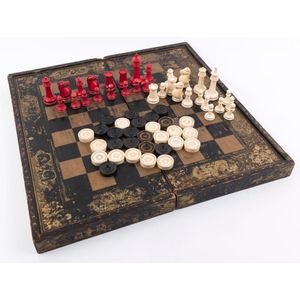Antique Staunton Chess & Draughts Set in Chinoiserie Box
Staunton chess & draughts set: pieces mostly in ivory with the black draught pieces in ebony (except 3 which are stained ivory), housed in original hinged games box with a chinoiserie decoration on lacquered wood; tallest piece (King) 9 cm high, board 56 x 56 cm when opened out; c.1860s.
You must be a subscriber, and be logged in to view price and dealer details.
Subscribe Now to view actual auction price for this item
When you subscribe, you have the option of setting the currency in which to display prices to $Au, $US, $NZ or Stg.
This item has been sold, and the description, image and price are for reference purposes only.
- Ebony - Ebony is a close grained timber, black in colour. It has a fine texture which can be polished to a high gloss, making it suitable for venereering, inlay and stringing and its use as solid timber is resticted to small decorative items and ornamental decoration, such as chess pieces and musical instrument parts. The term "ebonised" means "faux ebony", timber that has been darkened during the polishing process to resemble ebony.
- Ivory - Ivory is a hard white material that comes from the tusks of elephants, mammoth, walrus and boar, or from the teeth of hippopotamus and whales. The ivory from the African elephant is the most prized source of ivory. Although the mammoth is extinct, tusks are still being unearthed in Russia and offered for sale.
Ivory has been used since the earliest times as a material for sculpture of small items, both in Europe and the east, principally China and Japan.
In Asia ivory has been carved for netsuke, seals, okimono, card cases, fan supports, animals and other figures and even as carved tusks.
In the last 200 years in Europe ivory has been used to carve figures, for elaborate tankards, snuff boxes, cane handles, embroidery and sewing accessories, in jewellery and as inlay on furniture. Its more practical uses include being used for billiard balls, buttons, and a veneers on the top of piano keys.
The use and trade of elephant ivory have become controversial because they have contributed to Due to the decline in elephant populations because of the trade in ivory, the Asian elephant was placed on Appendix One of the Convention on International Trade in Endangered Species (CITES), in 1975, and in January 1990, the African elephant was similarly listed. Under Appendix One, international trade in Asian or African elephant ivory between member countries is forbidden. Unlike trade in elephant tusks, trade in mammoth tusks is legal.
Since the invention of plastics, there have been many attempts to create an artificial ivory - Staunton Chess Set - How should the king, queen, rooks and other pieces be depicted? Why is the king always the tallest piece and have a cross on his head. And why is the knight depicted as a horse head?
Until the adaption of a standard design, the designs of the pieces in every set varied. The Staunton chess set set a standard design for each piece used in the game of chess, and was the style adopted for use in chess competitions.
The Staunton designs were developed in 1849 and sold by sports and games manufacturers Jaques & Son of London, and were either designed by the proprietor of the firm, John Jaques or his his brother in law, Nathaniel Cook.
The design was named after Howard Staunton, an English chess player who was regarded as the leading player in the 1840s to 1850s.
The style has been popular for more than 160 years, and is still the standard today in tournament chess games and competitions. - Chinoiserie - Furniture and decorative items decorated in imitation of a Western interpretation of the Chinese style. The Chinoiserie style first became popular in the late 17th century, though there were frequent revivals, notably by Chippendale (hence 'Chinese Chippendale') during the Regency period, and the Anglo-Japanese style in the second half of the 19th century.
The ubiquitous 'willow pattern' is the most common 'Chinese' theme used in porcelain, while on furniture the Chinoiserie style usually has black or red painted and lacquered decoration, though the hallmark of the furniture style is the use of fretwork in geometrical patterns, pagodas and other decorative forms.
Japonaiseries, as the name implies, are motifs in imitation of the Japanese taste.
See also "Chinese Chippendale".
This item has been included into following indexes:
- games and puzzles, chess
- games and puzzles, various games
- games boxes and compendium 31
